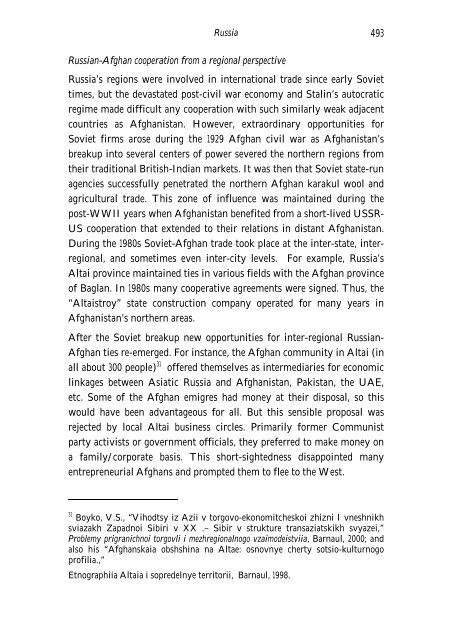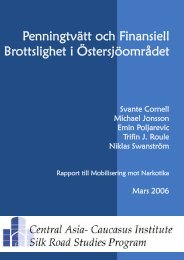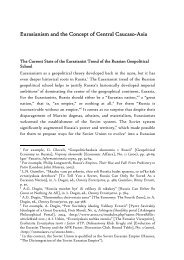Russia - Central Asia-Caucasus Institute and Silk Road Studies ...
Russia - Central Asia-Caucasus Institute and Silk Road Studies ...
Russia - Central Asia-Caucasus Institute and Silk Road Studies ...
You also want an ePaper? Increase the reach of your titles
YUMPU automatically turns print PDFs into web optimized ePapers that Google loves.
<strong>Russia</strong>n-Afghan cooperation from a regional perspective<br />
<strong>Russia</strong> 493<br />
<strong>Russia</strong>’s regions were involved in international trade since early Soviet<br />
times, but the devastated post-civil war economy <strong>and</strong> Stalin’s autocratic<br />
regime made difficult any cooperation with such similarly weak adjacent<br />
countries as Afghanistan. However, extraordinary opportunities for<br />
Soviet firms arose during the 1929 Afghan civil war as Afghanistan’s<br />
breakup into several centers of power severed the northern regions from<br />
their traditional British-Indian markets. It was then that Soviet state-run<br />
agencies successfully penetrated the northern Afghan karakul wool <strong>and</strong><br />
agricultural trade. This zone of influence was maintained during the<br />
post-WWII years when Afghanistan benefited from a short-lived USSR-<br />
US cooperation that extended to their relations in distant Afghanistan.<br />
During the 1980s Soviet-Afghan trade took place at the inter-state, interregional,<br />
<strong>and</strong> sometimes even inter-city levels. For example, <strong>Russia</strong>’s<br />
Altai province maintained ties in various fields with the Afghan province<br />
of Baglan. In 1980s many cooperative agreements were signed. Thus, the<br />
“Altaistroy” state construction company operated for many years in<br />
Afghanistan’s northern areas.<br />
After the Soviet breakup new opportunities for inter-regional <strong>Russia</strong>n-<br />
Afghan ties re-emerged. For instance, the Afghan community in Altai (in<br />
all about 300 people) 31 offered themselves as intermediaries for economic<br />
linkages between <strong>Asia</strong>tic <strong>Russia</strong> <strong>and</strong> Afghanistan, Pakistan, the UAE,<br />
etc. Some of the Afghan emigres had money at their disposal, so this<br />
would have been advantageous for all. But this sensible proposal was<br />
rejected by local Altai business circles. Primarily former Communist<br />
party activists or government officials, they preferred to make money on<br />
a family/corporate basis. This short-sightedness disappointed many<br />
entrepreneurial Afghans <strong>and</strong> prompted them to flee to the West.<br />
31<br />
Boyko, V.S., “Vihodtsy iz Azii v torgovo-ekonomitcheskoi zhizni I vneshnikh<br />
sviazakh Zapadnoi Sibiri v XX .– Sibir v strukture transaziatskikh svyazei,”<br />
Problemy prigranichnoi torgovli i mezhregionalnogo vzaimodeistviia, Barnaul, 2000; <strong>and</strong><br />
also his “Afghanskaia obshshina na Altae: osnovnye cherty sotsio-kulturnogo<br />
profilia.,”<br />
Etnographiia Altaia i sopredelnye territorii, Barnaul, 1998.






